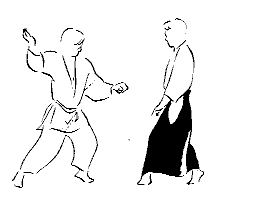 http://www.aikidofaq.com/bilder/gif89/irmi2.gif.html
http://www.aikidofaq.com/bilder/gif89/irmi2.gif.htmlThe Basic Physics http://www.aikidofaq.com/bilder/gif89/irmi2.gif.html
http://www.aikidofaq.com/bilder/gif89/irmi2.gif.html
Big vs. Small
Aikido is as much about basic physics as it is about the spiritual aspect. Aikido seeks to make the weak equal to the strong, and the big equal to the small simply by using some basic concepts of physics. By using torques, momentum and stability in the techniques, and relatively small and weak person can effectively defend themselves from an attack by a much larger person. Highly related to Judo, an art which also seeks to rob an uke of stability, Aikido incorporates many other martial arts as well, all of which contribute to the basic idea of unbalancing your uke by using their own energy against them. Equally important to making an uke unstable is retaining your own stability. A great deal of emphasis is placed upon the ability of an Aikidoist to stay "centered." In terms of physics, this is the control over the location of your center of mass. The movement of the center of mass from within one's body to a point where that person is no longer in equilibrium is the reason why people fall down. We'll take a closer look at how an Aikidoist manipulates his own center of mass, and the center of mass of others to perform techniques.
Newton's Laws
All three of Newton's laws can be applied to Aikido and the techniques therein. Lets take a look at them one at a time.
1) An object in motion tends to remain in motion.
An Aikidoist realizes that an object moving in a direction will probably continue in that direction. A giant thug charging at you is not going to be stopped easily, so why bother stopping him? By simply getting out of the way, and avoiding the attack an Aikidoist has already begun a technique. Certain techniques take advantage of the fact that a body in motion remains in motion. For the Timing-and-Breath throw, the uke is spun in a circle before an arm across the face halts their head's forward motion. Unfortunately for them, the rest of their body keeps moving forward and *plop* they fall to the ground.
2) F = ma.
Force equals mass times acceleration. Again, let us take the giant thug that is attacking. He has a great deal of mass, and depending upon his attack, a great deal of acceleration as well. So what must an Aikidoist do? Many of the techniques in Aikido focus on manipulating joints in a manner that requires very little force. By focusing on these vulnerable points in the body, an Aikidoist need only to apply an acceleration to a small mass (a hand) instead of a large mass (a body) to control his uke. By applying a wrist technique, the Aikidoist can get away with applying a small amount of force. The rest of the uke will follow, or lose their wrist.
3) Every action has an Equal and Opposite reaction.
The techniques of Aikido are primarily concerned with redirection of movement, and thus there is very little actual opposition to forces. Aikido techniques to not strike blows or bodily move an uke around. The third law applied whenever a small Aikido student tries to move a big uke. A small person cannot exert enough force to overcome his uke without also flinging himself halfway across the room. The small student can try and push the big uke over, but that uke's body will just push back with an equal force. The small student must therefore not exert direct force on his uke, but instead make good use of the other two laws.
Levers and Torques
Levers and torques are yet one more critically important aspect of the physics of Aikido. Many techniques make use of an ukes arm as a lever to exert a significant amount of torque to a shoulder or elbow joint. On the other side of things, an Aikidoist also places himself to rob his uke or attacker of a lever to use against him. Placement of arms, legs and body are critical to performing techniques correctly by providing the appropriate levers for an Aikidoist to apply techniques. Kaiten Nage uses the ukes arms as levers to apply a torque, and the Timing and breath throw shows the rotation of the uke's body around an axis in space.
Home - About - Basics - Kaiten Nage - Tenchi Nage - Timing and Breath - Nifty - Bibliography
